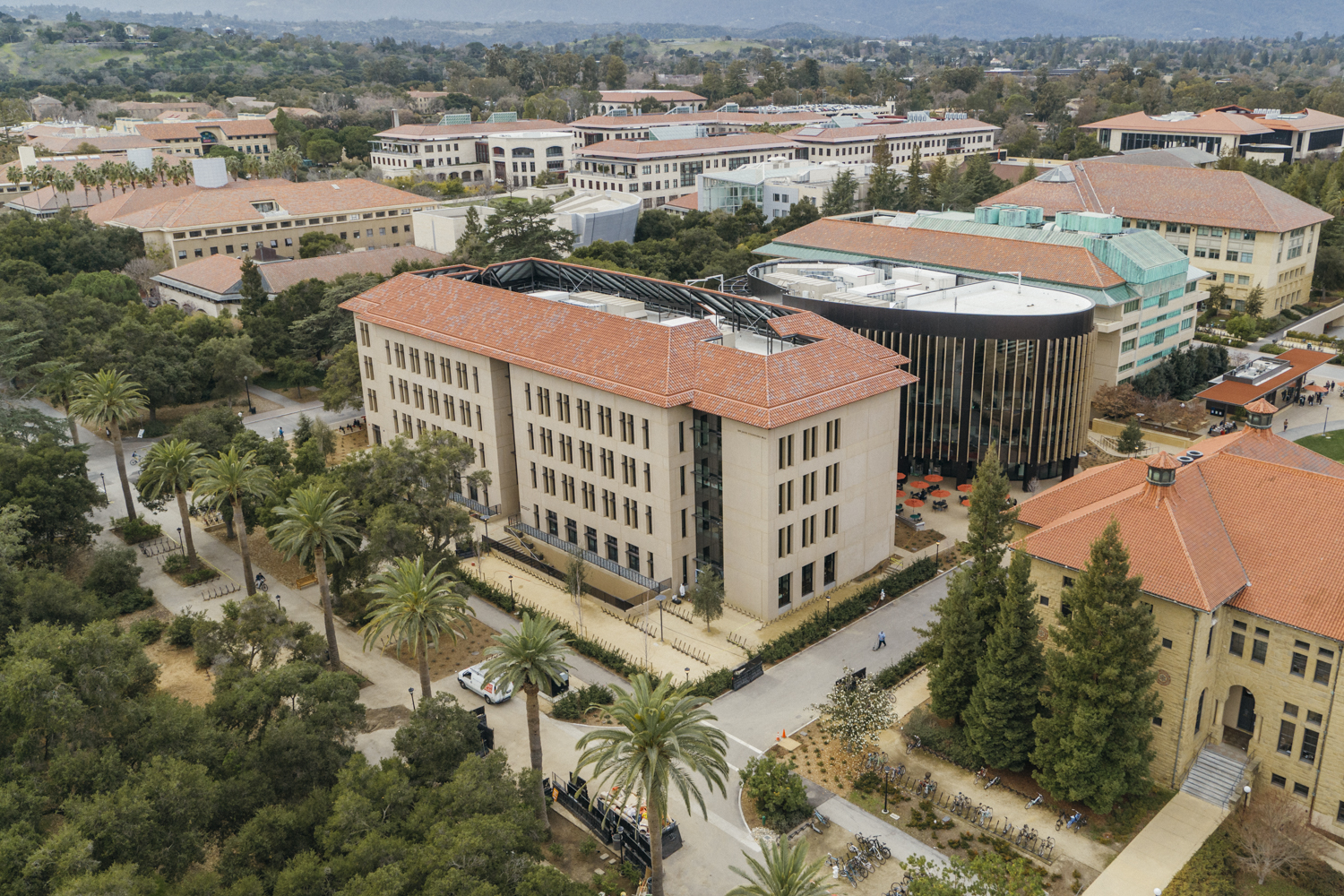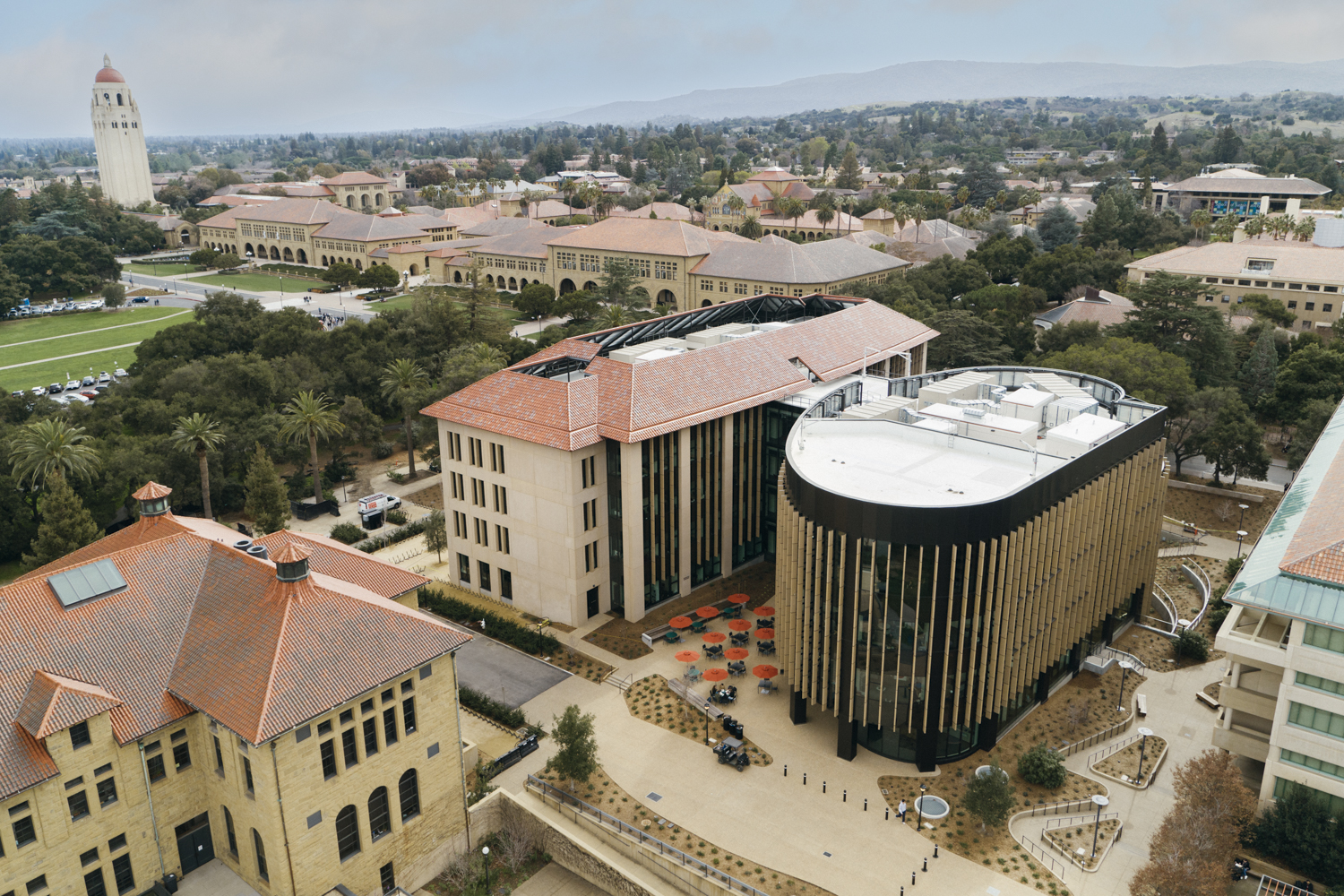As computing and data continue to influence nearly every facet of society, Stanford University is committing to the future of both with the opening of the new Computing and Data Science (CoDa) building.
“The Computing and Data Science building offers a collaborative and interdisciplinary space where members of our community across fields can work together to tackle complex, multifaceted problems – from chronic disease to climate change to food insecurity,” said President Jonathan Levin. “CoDa, and the programs that call it home, are central to our efforts to harness data-driven discovery to fuel advanced research at Stanford, a key university priority.”
CoDa is located at the corner of Lomita Mall and Jane Stanford Way, at the crossroads of the schools of Engineering and of Humanities and Sciences. Jennifer Widom, the Frederick Emmons Terman Dean of the School of Engineering, praised the new facility and the donors who made it possible.
“The opening of the new CoDa building offers an inspiring look into the future. With its state-of-the-art workspaces and adaptive teaching environments, CoDa fosters collaboration and enables data-driven discovery across a wide variety of fields,” she said. “We’re deeply grateful for the philanthropic support that helped make this vision a reality, and excited for students, faculty, and the broader community to enjoy CoDa as a place to spark bold ideas and new avenues of research and education.”
The need to understand and work with data and computing is expanding to more areas of study. While CoDa will be shared by the Department of Computer Science, the Department of Statistics, and Stanford Data Science (an initiative under the Vice Provost and Dean of Research), it will also support teaching and research at all of Stanford’s seven schools, including its largest, the School of Humanities and Sciences.
“In order to prepare our students for a rapidly changing world, we need to equip them with a greater understanding of how data and computing intersect with their chosen interests – whether it’s engineering, the social sciences, or the intersection of ethics and technology,” said Debra Satz, the Vernon R. and Lysbeth Warren Anderson Dean of the School of Humanities and Sciences.
Growth of discovery
Professor Emmanuel Candès, the Barnum-Simons Chair in Mathematics and Statistics and director of Stanford Data Science, said the growing demand for data science training and education stems from an explosion in data acquisition over the last 30 years. “Data has become easily accessible, and from it, people want to extract information,” he said. “That’s a big change and it puts our profession at the forefront.”
In 2018, Candès predicted that many future discoveries would be fueled by massive data analysis and lead to Nobel Prizes. Last year the prizes for physics and chemistry went to data scientists. CoDa, he said, will encourage similar breakthroughs across many fields by forging new connections.
“What’s exciting about the new building is the proximity it provides to other groups, like our computer science colleagues, and the interplay it will create,” he said. “When you change physical space, you tend to change the way you think.”
Professor Mehran Sahami, chair of the Department of Computer Science, said machine learning, like data science, is experiencing rapid growth and potential. “Machine learning is going to impact lots of different areas, such as education, medicine, and business,” he said. “So we’re thinking deeply about how these new developments and technologies can be deployed in service to people.”
That growth has helped drive the increasing demand for computer science training over the last 10 years. Sahami said that there are about 1,000 undergraduates in his department, making it the most popular major on campus. The department also has about 1,000 master’s students and 300 doctoral students, and teaches more course units than any other department at the university.
“The number of computer science faculty has also been growing, reflecting the greater variety of research in the field and the expanding opportunity for impact through that research,” he said. “All of this growth has increased the need for new, flexible teaching spaces.”
Toward this end, CoDa features a large seminar room and three large classrooms equipped with state-of-the-art media and capacity for 150, 180, and 250 students.
Modern facilities
Construction of CoDa broke ground in 2022, replacing a biology building. In addition to faculty from computer science, statistics, and data science – some of whom began moving in last month – CoDa will house Stanford Impact Labs and research data scientists overseeing Marlowe, Stanford’s GPU-based computational instrument. Four undergraduate majors (computer science, symbolic systems, and a pair of data science majors) comprising 25% of Stanford undergraduates will be based in CoDa.

CoDa blends traditional and modern: a tan facade and red-tiled roof on the east and glass exterior on the west.

The two wings of the building – one a rectangular shape, one an oval – connote the 1s and 0s binary code theme.
Built by Seattle-based LMN Architects, CoDa blends traditional and modern elements. The western side of the building features a cylindrical section with a rounded glass exterior, framed by a metal lattice that extends above the roof, giving it a futuristic look. In contrast, the east side has a tan facade and a red-tiled roof, echoing the architectural style of the central campus. Ample windows illuminate the building’s interior space, which totals 167,000 square feet. In addition to teaching space, the building includes offices for faculty, staff, lecturers, and graduate students, as well as a large student study area, rooms for group meetings, and private phone and conversation rooms. Occupying the entire fourth floor of the west building is a conference center that accommodates groups of up to 200.
There are racks for parking about 400 bikes and multiple open kitchenettes. Local coffee brewer Voyager Coffee will occupy the first-floor café space adjacent to a large courtyard.
Art and inspiration
A red motif features prominently throughout the building, including at its core, where a distinct red staircase connects all five floors. The side panels of the stairs contain a pattern of 1s and 0s – binary notation that visitors are invited to decode. The two wings of the building – one a rectangular shape, one an oval – also connote the 1s and 0s theme.
Winding through the staircase is the interactive art installation Fathom by Camille Utterback, associate professor of art and art history in the School of Humanities and Sciences. The Stanford University Public Art Committee commissioned Utterback to create the permanent work comprising five hand-painted and etched triangular glass panels that depict historical and contemporary methods of encoding or working with data. At night, the glass is illuminated with dynamic computer-generated projections seen from inside and outside the building. The piece is also responsive to human presence and movement in the building, with some of the projected animations reacting to cameras near the triangles. Utterback is currently testing content and will complete the artwork by the end of March.
The ribbon-cutting ceremony for CoDa will take place on April 15.
For more information
Robin Wander contributed reporting to this piece.
Emmanuel Candès is also a professor of electrical engineering (by courtesy) and a member of the Institute for Computational and Mathematical Engineering at Stanford University.
Mehran Sahami is the Tencent Chair of the Computer Science Department and the James and Ellenor Chesebrough Professor in the School of Engineering.
Camille Utterback is also associate professor (by courtesy) in the Department of Computer Science in the School of Engineering.